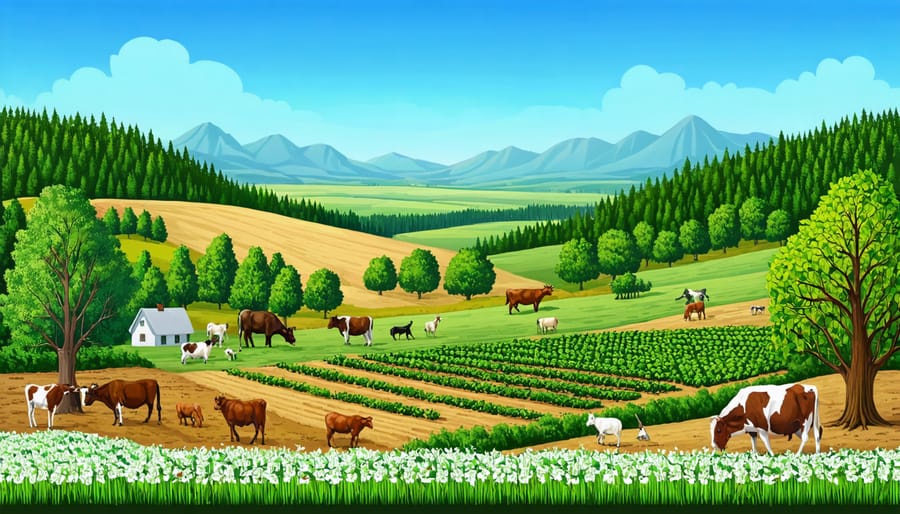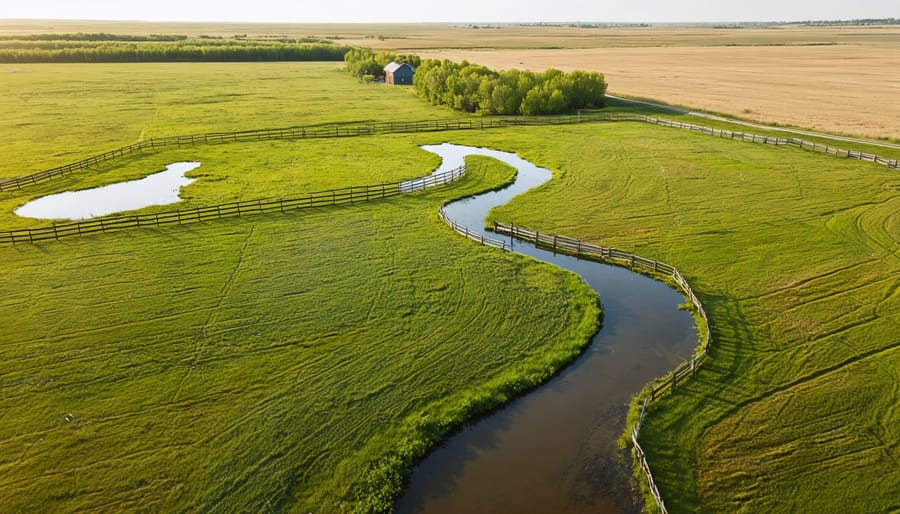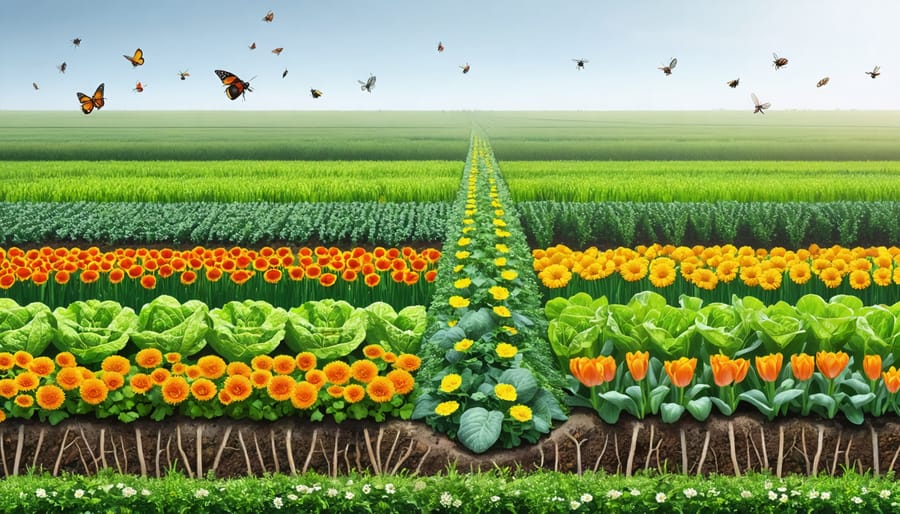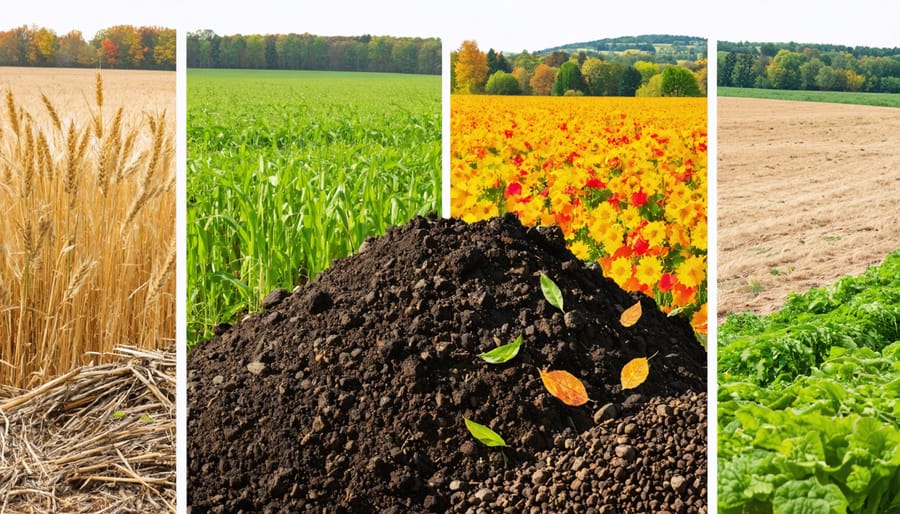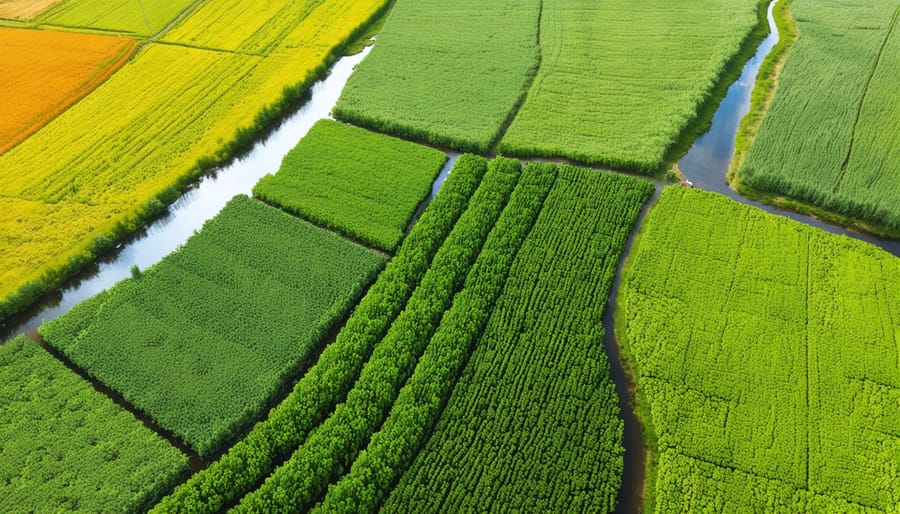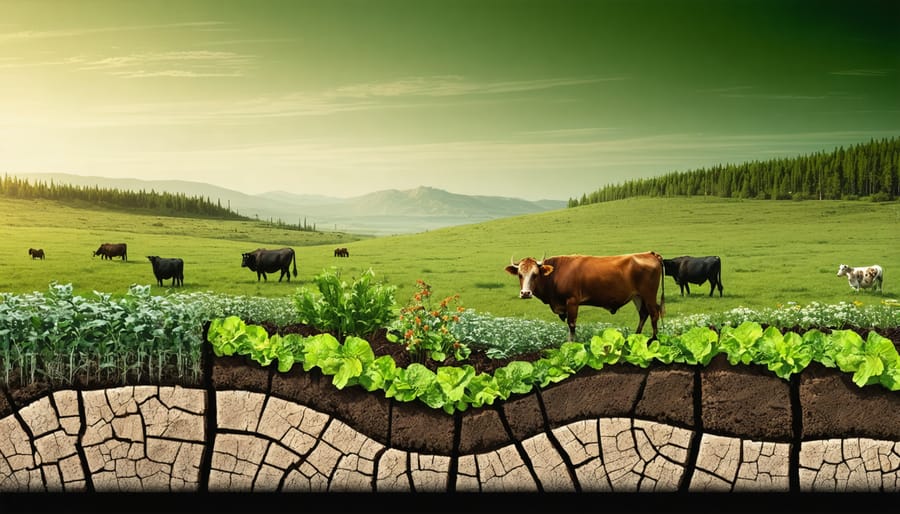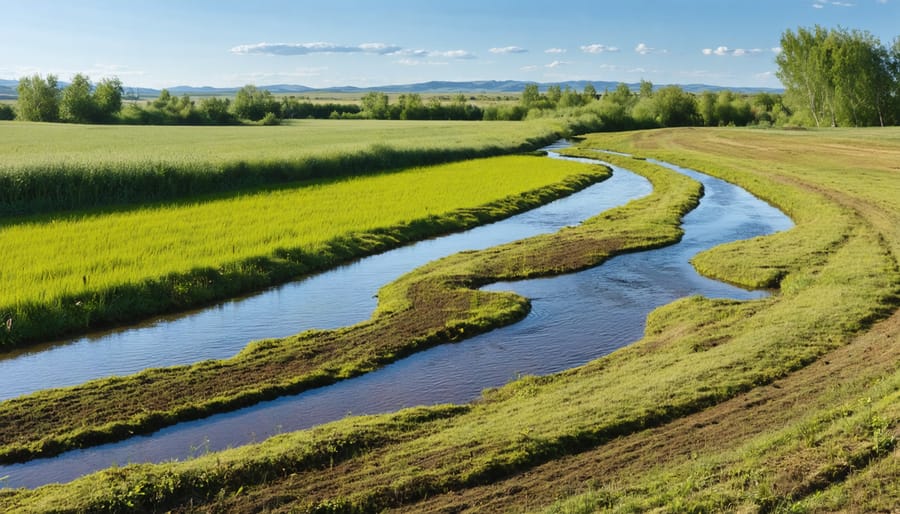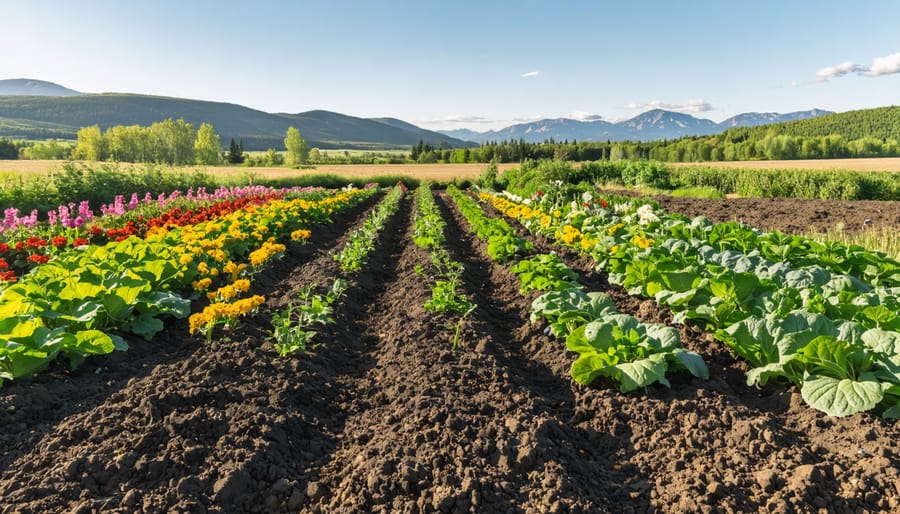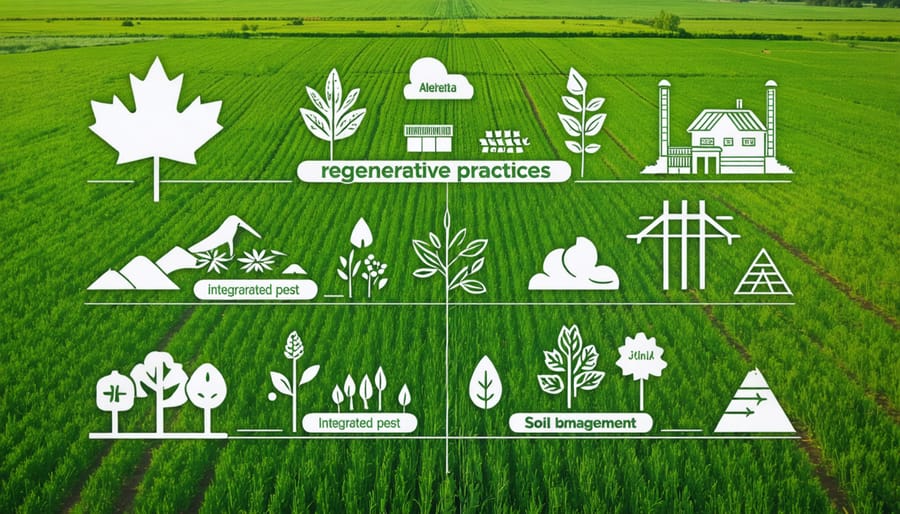In the heart of Alberta’s farmlands, a quiet revolution is taking root. Regenerative agroforestry transforms conventional agriculture into a dynamic ecosystem where trees, crops, and livestock work in harmony to build soil health, increase biodiversity, and strengthen farm resilience. By strategically integrating trees and shrubs with traditional farming practices, Canadian farmers are discovering a powerful way to combat climate challenges while enhancing their bottom line.
This time-tested approach, refined through generations of indigenous knowledge and modern scientific research, offers a compelling solution to many of the challenges facing Canadian agriculture today. From protecting crops against extreme weather events to creating new revenue streams through diversified production, regenerative agroforestry represents a practical path forward for farmers seeking both environmental and economic sustainability.
As droughts, floods, and market uncertainties continue to challenge our agricultural communities, regenerative agroforestry emerges as more than just a conservation strategy – it’s a robust business model that builds farm resilience while regenerating the land for future generations. Through carefully planned systems of shelterbelts, silvopasture, and alley cropping, Alberta farmers are pioneering approaches that work within our unique climate and growing conditions, proving that profitability and environmental stewardship can go hand in hand.
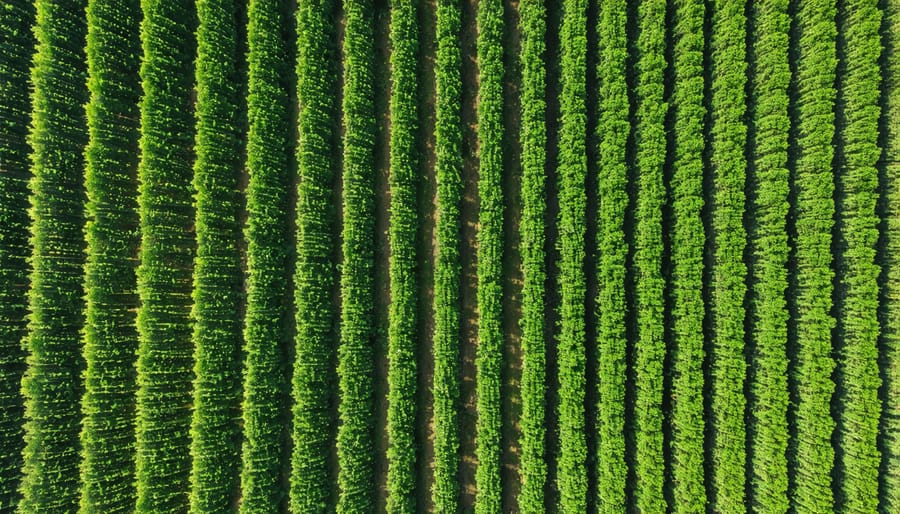
The Power of Trees in Regenerative Agriculture
Carbon Sequestration Benefits
Regenerative agroforestry systems excel at carbon sequestration in agriculture, offering a powerful tool for climate-smart farming. When trees and shrubs are integrated into cropland, they create a multi-layered system that captures carbon both above and below ground. The deep root systems of trees can store carbon at depths of up to 2 metres, while their canopies continuously absorb CO2 through photosynthesis.
In Alberta’s agricultural landscape, a well-designed agroforestry system can sequester between 5 and 10 tonnes of carbon per hectare annually. This happens through multiple pathways: woody biomass accumulation, increased soil organic matter, and enhanced microbial activity in the root zone. The presence of permanent vegetation also reduces soil disturbance, allowing carbon to remain locked in the soil for longer periods.
What sets agroforestry apart is its ability to maintain carbon stocks while supporting active agricultural production. Unlike traditional carbon offset projects, these systems continue to sequester carbon while providing valuable crops, timber, and ecosystem services, making them a practical choice for forward-thinking Canadian farmers.
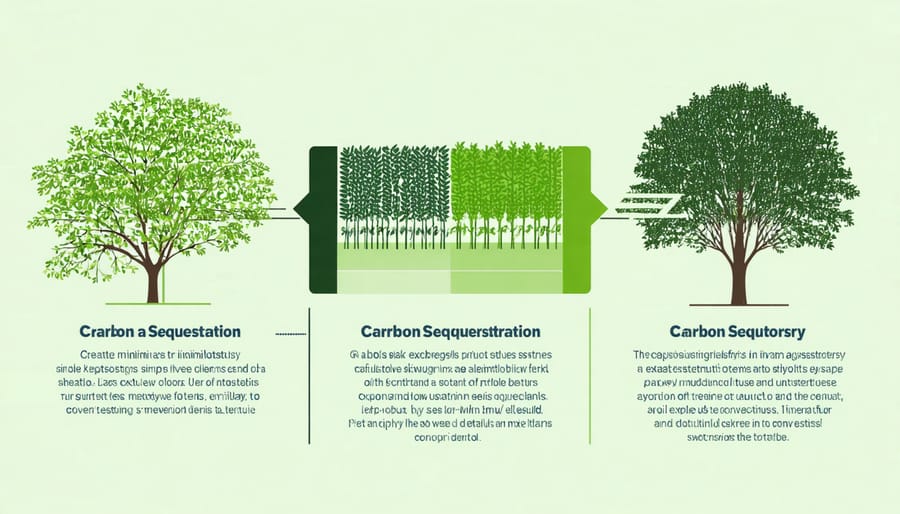
Soil Health Enhancement
Trees play a vital role in enhancing soil quality through multiple natural processes that benefit the entire farm ecosystem. Through their extensive root systems, trees improve soil health management by preventing erosion and creating stable soil structure. In Alberta’s prairie regions, where wind erosion can be particularly challenging, strategically planted trees act as natural windbreaks while their roots hold soil particles together.
The leaf litter and organic matter from trees contribute significantly to soil fertility. As leaves decompose, they release essential nutrients like nitrogen, phosphorus, and potassium back into the soil. Deep-rooted trees also access nutrients from lower soil layers, bringing them to the surface and making them available to other crops. This natural nutrient cycling reduces the need for synthetic fertilizers.
Trees also support beneficial soil microorganisms and mycorrhizal fungi networks. These underground partnerships enhance nutrient uptake and water retention, creating a more resilient growing environment. For Alberta farmers dealing with variable rainfall patterns, this improved water-holding capacity can make a significant difference in crop success during dry periods.
Designing Your Agroforestry System
Species Selection for Alberta
In Alberta’s diverse climate zones, successful agroforestry depends on selecting species that can thrive in our unique conditions. For trees, hardy varieties like trembling aspen, white spruce, and Siberian larch have proven successful across the province. These species demonstrate excellent cold hardiness and can serve multiple purposes, from windbreaks to timber production.
When selecting companion crops, consider plants that benefit from partial shade and root zone sharing. Saskatoon berries, chokecherries, and hazelnuts are excellent understory options that provide marketable products while contributing to soil health. For the herbaceous layer, shade-tolerant plants like goldenseal, wild ginger, and various native mushroom species can create additional revenue streams.
Successful combinations we’ve seen in Alberta include white spruce with saskatoon understory and mushroom cultivation, or hybrid poplar systems integrated with hay production. These pairings maximize vertical space while optimizing soil nutrients and water usage.
Climate considerations are crucial – choose species that can handle your specific zone’s precipitation patterns and temperature extremes. The Peace Region, for example, benefits from drought-resistant varieties, while central Alberta can support more moisture-loving species.
Remember to source stock from local nurseries when possible, as these plants are often pre-adapted to regional conditions. Consider consulting with local agricultural extension offices or experienced agroforesters who can provide guidance based on your specific site conditions and goals.
Layout and Spacing Considerations
Proper spacing and layout are crucial elements in successful regenerative agroforestry systems. In Alberta’s diverse landscape, tree rows should typically be spaced 20 to 30 metres apart to accommodate machinery and maximize light distribution. This spacing allows for effective cultivation of crops or grazing areas between rows while ensuring trees don’t overshadow other plants.
When planning your layout, consider prevailing winds and sun exposure. In our northern latitude, orient tree rows east-west when possible to minimize shading effects on crops. For wind protection, north-south orientations work well, particularly in areas prone to strong westerly winds.
Within tree rows, spacing between individual trees depends on species selection and management goals. Fast-growing species like hybrid poplars need 3-4 metres between trees, while fruit trees typically require 4-6 metres. Understory plants should be positioned 1-2 metres from tree trunks to reduce competition for nutrients and water.
For livestock integration, ensure alleyways between tree rows are wide enough for animal movement and grazing patterns. A minimum width of 15 metres is recommended for cattle, while sheep and poultry systems can work with narrower spacing of 12-15 metres.
Remember to incorporate access routes for maintenance and harvest. Plan for 6-metre-wide equipment lanes at regular intervals, typically every 100-200 metres, depending on your property size and machinery requirements.
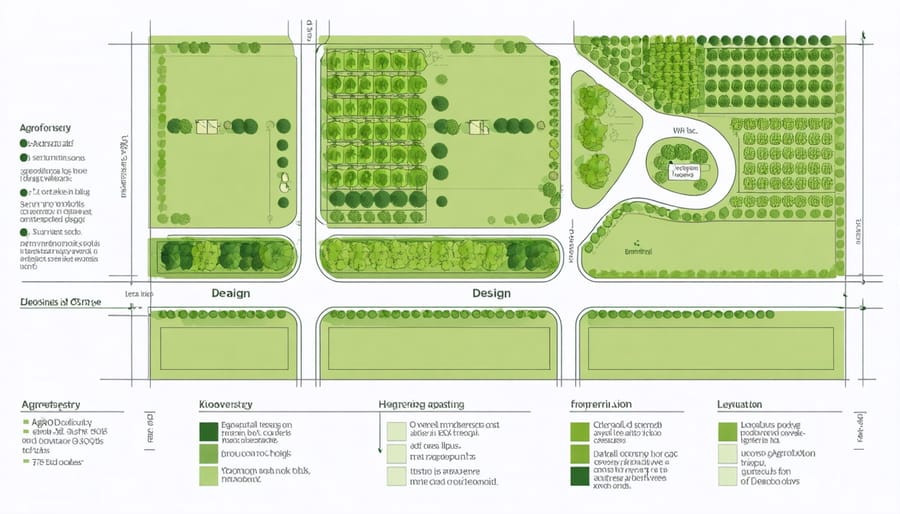
Integration with Existing Farm Operations
Transitioning from conventional farming to regenerative agroforestry doesn’t have to happen overnight. Many Alberta farmers have found success by starting with small pilot areas and gradually expanding their agroforestry systems over time. The key is to integrate new practices while maintaining existing farm operations.
A practical approach is to begin with field borders or marginally productive areas. These zones can be transformed into windbreaks or shelterbelts using native species like white spruce and trembling aspen, which are well-adapted to our climate. This initial step provides immediate benefits like wind protection while allowing farmers to maintain their primary production areas.
For livestock operations, silvopasture can be introduced by strategically planting trees in existing pastures. Many Alberta ranchers have successfully integrated this approach by starting with 2-3 hectare test plots, allowing them to learn and adjust their management strategies before scaling up.
Record-keeping is essential during the transition. Track changes in soil health, moisture retention, and livestock behaviour to measure success and make informed decisions. Local agricultural extension offices and experienced agroforesters can provide valuable guidance during this process.
Financial planning is equally important. Consider accessing government programs like the Canadian Agricultural Partnership, which offers funding for sustainable agriculture initiatives. Many farmers find success by implementing changes in 20% increments over five years, allowing for gradual investment and learning while maintaining stable farm income.
Remember, successful integration often means working with, rather than against, existing farm systems and knowledge.
Success Stories from Alberta’s Pioneers
The Johnson Family Farm Transformation
Located just outside of Olds, Alberta, the Johnson family farm’s transformation stands as a remarkable example of successful regenerative agroforestry implementation. In 2015, Sarah and Mike Johnson inherited their 400-hectare conventional grain farm and faced declining soil health and rising input costs. Their journey toward regenerative practices began with careful planning and community support.
The Johnsons started by introducing shelterbelts of native white spruce and trembling aspen along field boundaries, which now protect their crops from harsh winds and provide habitat for beneficial insects. They integrated fruit-bearing saskatoon bushes and haskap berries between crop rows, creating additional revenue streams while improving soil structure.
Within three years, the family documented a 40% reduction in synthetic fertilizer use, thanks to nitrogen-fixing support crops and improved soil biology. Their innovative approach includes rotational grazing of cattle through their tree systems during winter months, which has eliminated the need for separate winter feed storage while providing natural fertilization.
The farm’s transformation wasn’t without challenges. “The first two years were the toughest,” Sarah recalls. “We had to learn entirely new systems while managing cash flow.” However, by year four, their soil organic matter increased from 2% to 4.5%, and water retention improved significantly, helping them weather the drought of 2021 better than neighboring farms.
Today, the Johnsons host regular field days, sharing their experience with other Alberta farmers. Their annual revenue has increased by 35% through diversified income streams, including direct-to-consumer berry sales and premium prices for their regeneratively raised grain crops. Their success demonstrates how regenerative agroforestry can thrive in Alberta’s climate while building resilient farm operations.
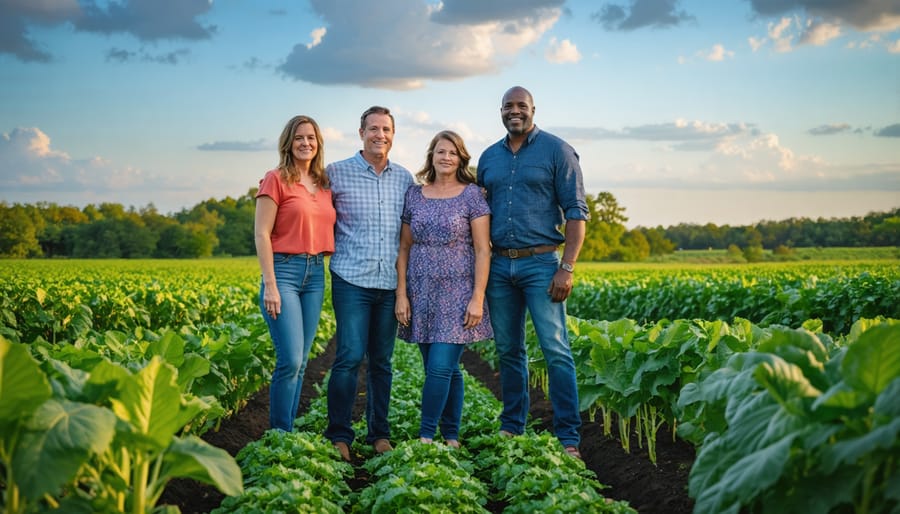
Community-Led Forest Farm Initiative
The Community-Led Forest Farm Initiative in Red Deer County, Alberta, demonstrates the power of collaborative agroforestry in building resilient local food systems. Started in 2019 by a group of 12 farmers, this project has transformed 240 hectares of conventional farmland into a thriving network of integrated forest farms.
The initiative combines traditional Indigenous knowledge with modern sustainable practices, creating a unique model that’s particularly suited to Alberta’s climate. Participating farmers work together to manage shared resources, including a community nursery that produces over 15,000 native tree seedlings annually.
Key components of the project include mixed fruit orchards, silvopasture systems for cattle grazing, and urban agroforestry systems that connect with nearby communities. The initiative has created opportunities for knowledge sharing through monthly workshops and mentorship programs.
After three years, participating farms have reported significant improvements:
– 35% increase in soil organic matter
– 40% reduction in water usage
– Creation of 25 new local jobs
– Development of value-added products from forest crops
The success of this initiative has inspired similar projects across Alberta, with five new community-led forest farms launching in 2023. The Red Deer model showcases how collaborative approaches can overcome common barriers to agroforestry adoption, such as high initial costs and limited technical expertise.
The project maintains strong partnerships with local Indigenous communities, agricultural extension services, and research institutions, ensuring continuous learning and adaptation of practices to meet changing environmental conditions.
Economic Benefits and Support Programs
Revenue Diversification
One of the most compelling aspects of regenerative agroforestry is its ability to generate multiple revenue streams throughout the year. While traditional farming often relies on single-season crop yields, agroforestry systems create diverse income opportunities that help stabilize farm finances and reduce economic risk.
Many Alberta farmers are already profiting from sustainable agriculture through carefully planned revenue diversification. A well-designed agroforestry system can generate income from timber, fruit and nut production, medicinal plants, honey production, and seasonal crops.
For example, the understory can produce mushrooms and shade-tolerant herbs in spring, while fruit trees provide harvests in summer and fall. Winter activities might include maple syrup production or harvesting windbreak trees for woodcraft materials. Additionally, many farmers have found success marketing unique products like tree-ripened fruits or forest-raised poultry to local restaurants and farmers’ markets.
Carbon credits represent another emerging revenue stream, with several Alberta farms now receiving payments for their carbon sequestration efforts. Some producers have also developed agritourism opportunities, offering educational tours and workshops that showcase their regenerative practices.
The key to successful revenue diversification lies in careful planning and phased implementation. Start with two or three complementary enterprises and gradually expand based on market demand and management capacity.
Available Grants and Resources
Several funding opportunities are available to Alberta farmers interested in implementing regenerative agroforestry practices. The Canadian Agricultural Partnership (CAP) offers grants of up to $50,000 through their Environmental Stewardship and Climate Change Producer program, supporting the establishment of shelterbelts and silvopasture systems.
The Agricultural Climate Solutions program, administered by Agriculture and Agri-Food Canada, provides funding specifically for carbon sequestration projects, including agroforestry initiatives. Farmers can receive up to 75% cost-share on eligible projects.
Local conservation authorities, such as ALUS Canada (Alternative Land Use Services), offer annual payments for ecosystem services provided by agroforestry systems. These payments typically range from $15 to $40 per acre, depending on the project’s scope and environmental benefits.
The Alberta Conservation Association provides technical support and cost-sharing opportunities through their Conservation, Community, and Education Grants. First-time applicants can receive priority consideration for implementation projects.
Resource support is also available through organizations like the Agroforestry and Woodlot Extension Society (AWES), which offers free consultations, workshops, and educational materials. The Alberta Woodlot Extension Program provides specialized technical assistance for tree selection and management planning.
To access these opportunities, contact your local agricultural fieldman or visit the Alberta Agriculture and Forestry website for current application deadlines and eligibility requirements.
As we’ve explored throughout this article, regenerative agroforestry offers Canadian farmers a powerful pathway to enhance their land’s productivity while contributing to environmental sustainability. The integration of trees and shrubs with traditional farming practices isn’t just about environmental stewardship – it’s about building resilient farm operations that can weather the challenges of our changing climate while maintaining profitable yields.
The success stories we’ve seen across Alberta demonstrate that this approach is both practical and profitable. From the mixed-wood parkland regions to the prairie landscapes, farmers are discovering that thoughtful implementation of agroforestry principles can lead to improved soil health, increased biodiversity, and new revenue streams through diversified products.
To begin your journey into regenerative agroforestry, consider starting with these actionable steps:
1. Assess your land’s current conditions and identify areas that could benefit from tree integration
2. Connect with local agricultural extension offices and agroforestry networks
3. Start small with a pilot project on a portion of your land
4. Document your progress and adjust your approach based on results
4. Seek out mentorship from experienced practitioners in your region
Remember that support is available through various Canadian agricultural programs, including funding opportunities and technical assistance. Your local conservation authority and agricultural societies can provide valuable resources and connections to other farmers practicing regenerative agroforestry.
The transition to regenerative agroforestry doesn’t happen overnight, but the long-term benefits make it a worthwhile investment. As more Alberta farmers embrace these practices, we’re building a stronger, more resilient agricultural community that can thrive for generations to come.
Take the first step by reaching out to your local agricultural extension office or joining one of the many farmer-led networks focused on regenerative practices. Your journey toward a more sustainable and profitable farming future starts with that initial decision to explore the possibilities of regenerative agroforestry.

